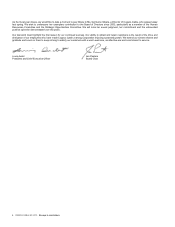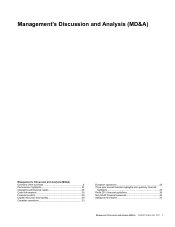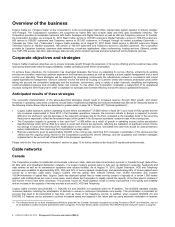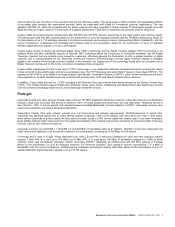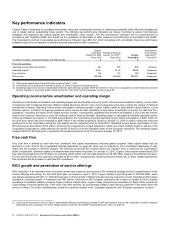Cogeco 2010 Annual Report Download - page 17
Download and view the complete annual report
Please find page 17 of the 2010 Cogeco annual report below. You can navigate through the pages in the report by either clicking on the pages listed below, or by using the keyword search tool below to find specific information within the annual report.
16 COGECO CABLE INC. 2010 Management’s Discussion and Analysis (MD&A)
The implementation project consists of three primary phases, which may occur concurrently as IFRS are applied to specific areas of operations:
Phase Area of impact Key activities Status
Scoping and
diagnostic
Pervasive Perform a high-level impact assessment to identify key areas that are expected to be impacted
by the transition to IFRS.
Completed
Rank IFRS impacts in order of priority to assess the timing and complexity of transition efforts
that will be required in subsequent phases.
Impact analysis,
evaluation and
design
For each area
identified in the
scoping and
diagnostic phase
Identify the specific changes required to existing accounting policies. Completed
Analyse policy choices permitted under IFRS.
Present analysis and recommendations on accounting policy choices to the Audit Committee.
Pervasive Identify impacts on information systems and business processes. Completed
Prepare draft IFRS consolidated financial statement template.
Identify impacts on internal controls over financial reporting and other business processes.
Implementation and
review
For each area
identified in the
scoping and
diagnostic phase
Test and execute changes to information systems and business processes. Completed
Obtain formal approval of required accounting policy changes and selected accounting policy
choices.
In progress - to be
completed in
fiscal 2011
Communicate impact on accounting policies and business processes to external stakeholders. To be completed
during fiscal 2011
Pervasive Gather financial information necessary for opening balance sheet and comparative IFRS
financial statements.
In progress - to be
completed in fiscal
2011
Update and test internal control processes over financial reporting and other business
processes.
Collect financial information necessary to compile IFRS-compliant financial statements. In progress - to be
completed during fiscal
2012
Provide training to employees and end-users across the organization.
Prepare IFRS compliant financial statements.
Obtain the approval from the Audit Committee of the IFRS consolidated financial statements.
Continually review IFRS and implement changes to the standards as they apply to the
Corporation.
To be completed
throughout transition
and post-conversion
periods
The Corporation’s project for the transition from Canadian GAAP to IFRS is progressing according to the established plan and the Corporation
expects to meet its target date for migration.
Business combinations, consolidated financial statements and non-controlling interests
In January 2009, the CICA issued Handbook Section 1582, Business combinations, which replaces Section 1581 of the same name, and
Sections 1601, Consolidated Financial Statements and 1602, Non-controlling interests, which together replace Section 1600, Consolidated
Financial Statements. These new sections harmonize significant aspects of Canadian accounting standards with the IFRS that will be
mandated for publicly accountable entities with fiscal years beginning on or after January 1, 2011.
Section 1582 requires that all business acquisitions be measured at the fair value of the acquired entity at the acquisition date even if the
business combination is achieved in stages, or if less than 100% of the equity interest in the acquiree is owned at the acquisition date, and
expands the definition of a business subject to an acquisition. The section also establishes new guidance on the measurement of consideration
given and the recognition and measurement of assets acquired and liabilities assumed in a business combination. Furthermore, under this new
guidance, acquisition costs, which were previously included as a component of the consideration given, and any negative goodwill resulting
from the allocation of the purchase price, which was allocated as a reduction of non-current assets acquired under the previous standard, will
be recorded in earnings in the current period. This new section will be applied prospectively and will only impact the Corporation’s consolidated
financial statements for future acquisitions concluded in periods subsequent to the date of adoption.
Sections 1601 and 1602 dealing with consolidated financial statements require an entity to measure non-controlling interest upon acquisition
either at fair value or at the non-controlling interest's proportionate share of the acquiree's identifiable net assets. The new sections also require
non-controlling interest to be presented as a separate component of shareholders' equity.
The new standards will apply as of the beginning of the first annual reporting period beginning on or after January 1, 2011, with simultaneous
early adoption permitted. Early adoption may reduce the amount of restatement required upon conversion to IFRS. The Corporation has
elected not to early-adopt these sections, and in light of the harmonization of Canadian and International accounting standards taking effect at
that same date, these sections will not be applicable to the Corporation.


